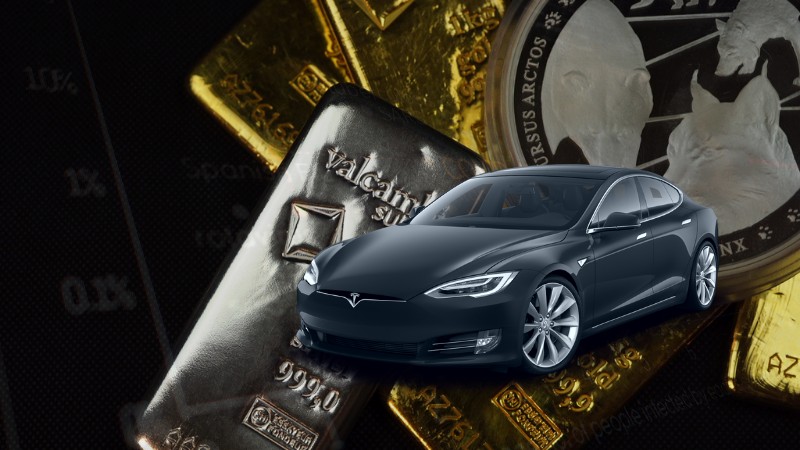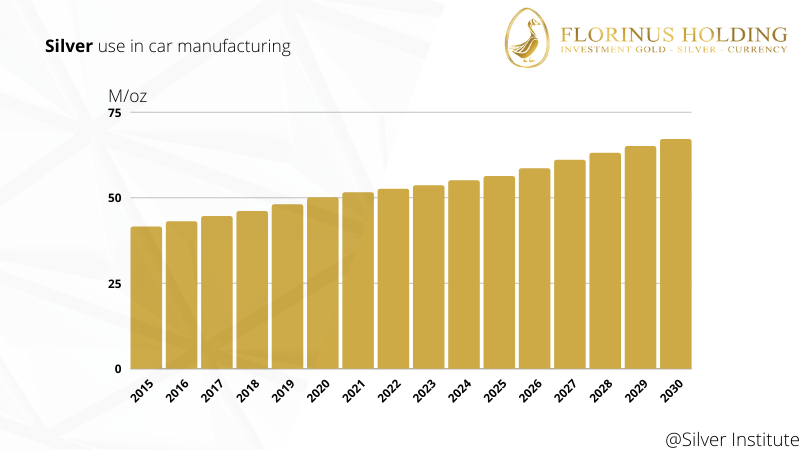Here is how precious metals in cars influence market prices
Publicēšanas laiks - 2022.01.27
The amount of produced cars constantly increases annually. How it will affect precious metal prices?
Precious metals in the automobile manufacturing industry are mostly used in car parts like engine sensors and catalytic converters. Emerging regulations push for more sophisticated technologies which mean that precious metals in cars should be more prominent.
The automobile manufacturing industry consumes more than half the world’s platinum mine output. Consequently, such demand is one of the key influences on precious metal prices. To elaborate, we cover the essential elements that make up the framework of precious metals in the car manufacturing industry.
Precious metals in cars
In 2010 global automobile production was 80 million and experts forecast that this number will increase to 200 million by 2050. Moreover, the number of hybrid vehicles shall hit the mark of 130 million vehicles per year in 2040.
The car manufacturing industry is set to soar in the future due to technological developments. To prevent pollution issues governments call for more environment-friendly solutions. Let’s explore how precious metals help to meet these occurring demands and other uses.
Precious metals in catalytic converters
Over the past 30 years, diesel-fueled and petrol car manufacturing companies have utilized mostly platinum as a component in catalytic converters. Platinum is environment-friendly material that efficiently turns toxic car emissions into less harmful.
The catalyst which is part of the catalytic converter is covered with a layer of platinum. The amount of platinum depends on the size of the vehicle produced.
Catalytic converters reduce NOx (Nitrogen oxide) to nitrogen as well as oxidize CO (carbon monoxide) and hydrocarbons. Which in turn generates cleaner exhaust that meets emission standards.
Why platinum is the main choice as other transition elements are capable of oxidation reactions? Platinum holds several key advantages:
- It has a high melting point (1,768 °C). So it withstands extremely high operating temperatures.
- The effects of poisonous gasses are limited on the surface of the metal.
- Platinum can be efficiently recycled from cars.
Silver and gold in cars
Computers are inseparable automobile parts. They monitor engine emissions and keep them as low as possible. Also, the computer receives a lot of different information from many different sensors.
The car manufacturing industry uses over 60 million ounces of silver annually in motor vehicle production. Even though the amount of precious metals in cars is small, the grand total adds up. Considering that car manufacturers produce millions of vehicles each year.
The circuit boards that hold together all the exquisite sensors and the components required for the steady operation almost always include gold and silver. You can also mention the traces of gold in airbag sensors, audio systems, and decorative elements in luxurious cars.
Car emission standards
Cars significantly enhance the quality of our daily lives. However, it also contributes to various problems like the depletion of energy resources, environmental pollution, global warming, and traffic accidents. The Euro 6 regulations that shook up the car manufacturing industry in September 2014 propelled it even further.
By adopting Euro 6 vehicle standards, EU countries aim to achieve up to a 99 percent reduction in emission pollutants. The regulations become prominent not only in Europe but also in other world’s major regions. Consequently, car manufacturers require increasingly more precious metals to meet the changing demands.
Precious metals in fuel cells
Automobile industry experts investigate the possibility of using hydrogen as a fuel to battle emissions. Hydrogen fuel cell technology relies on platinum group metals that withstand high temperatures. These metals work as a catalyst that helps to burn hydrogen with oxygen which doesn’t emit toxic substances. This is a core technology that makes it an alternative to battery-powered vehicles. Moreover, such a solution could eliminate the need for inefficient thermal engines.
On the other hand, low-temperature fuel cells also need a significant amount of platinum for the exchange of energy. The issue of limited precious metal resources remains in the alternative fuel industry as well. Innovators have to make considerable efforts in trying to reduce the amount of platinum used by fuel cells.
Car recycling
As we pointed out earlier the car manufacturing market forecasts a demand increase for precious metals in cars. It uses more than half of the world’s platinum, palladium, and rhodium.
The growing demand for automobiles escalates larger precious metal mining volumes. Mining companies have to process roughly one ton of ore just to obtain three to seven grams of platinum. Which approximately covers four different cars.
Mining the metals won’t fulfil these demands if alternative sources are not discovered. Luckily there are is an alternative. Scarp metal and cars that are not used anymore still offer precious metals to be extracted if recycled.
Kochi Sakairi, Executive Researcher of Automobile industry reflects on the situation: “Unless the world recycles at least as much as it mines — and preferably more — meeting that demand will be impossible.”Luckily company NIPPON PGM, TANAKA came across a valuable business solution. They set out a goal to extract 37 tons of platinum from scrap annually. Which is the amount that covers around 35% of the annual demand for automobile catalytic converters.
Gold is another example of how we miss out on large quantities in end-of-life vehicles. It is estimated that the amount is in the same order of magnitude as the quantity in electronic scrap.
However, the amounts of gold are very little in the single-car. Frankly, it is quite difficult to extract the material that is spread out in small quantities (usually one to two grams of gold per vehicle). So it is up to the main innovators of the industry to discover an effective way to collect it.
To sum it up
In order to understand the nature of precious metal prices better, it’s quite important to keep track of the automobile manufacturing industry. These businesses currently face several issues that may turn precious metals into major commodities.
Moreover, major shifts caused by environmentally-friendly policies will require car manufacturing companies to meet the rising demands. Precious metals will be inseparable from the technological advancements in the industry, which is one of the main reasons behind growing manufacturing volumes.
On the other hand, the limited amount of precious metals may undermine the production capacity if an alternative for mining metals won’t show up. Which will possibly create an influence on the prices of platinum, palladium, and other platinum group metals.
Pierakstieties Florinus jaunumiem un uzziniet pirmais par preču papildinājumiem, ekskluzīvām akcijām, īpašajiem piedāvājumiem un daudz ko citu!
Abonēt jaunumus

